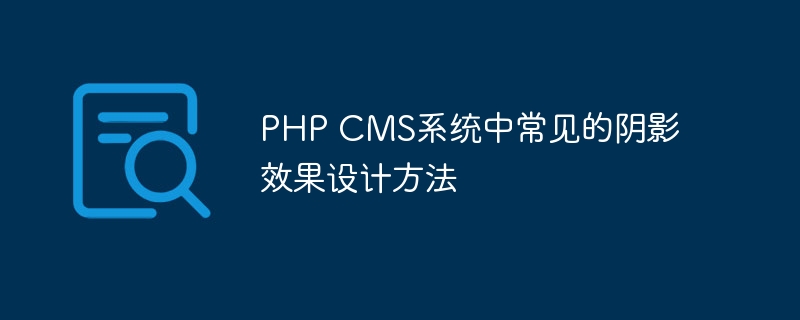Home >Backend Development >PHP Tutorial >Common shadow effect design methods in PHP CMS systems
Common shadow effect design methods in PHP CMS systems
- PHPzOriginal
- 2024-03-27 09:36:04855browse

With the continuous development of the Internet, content management systems (CMS) have become the first choice for many corporate and personal websites. As a mainstream website development language, PHP is also widely popular for the CMS system it develops. Among them, shadow effects have become one of the techniques commonly used by designers and developers. This article will introduce common shadow effect design methods in PHP CMS systems.
1. The meaning of shadow effect
The shadow effect refers to a virtual three-dimensional effect produced by the gradient or darkening or deepening of color, which can create a sense of three-dimensionality and depth. In website design, the shadow effect can not only improve the beauty of the page, but also allow users to better understand the hierarchy of the web page, thereby better experiencing the content of the web page.
2. Common shadow effects
1. Text shadow effect
The text shadow effect is the most common one in CMS systems. Its function is to make the text stand out from the background. It stands out and makes the page more layered. The implementation is also simple, just use the text-shadow property in CSS. Here is an example:
h1 {
text-shadow: 2px 2px 2px #333;
}In this example, the text of the h1 element is given the characteristics of being offset by two pixels to the lower right, with a shadow radius of 2 pixels, and a shadow color of #333.
2. Image shadow effect
The image shadow effect can make the image stand out from the page, and can also add a sense of hierarchy to the website. The implementation method is also very simple, just set the box-shadow attribute in CSS. Here is an example:
img {
box-shadow: 2px 2px 2px #333;
}In this example, the box model of the picture element will have a shadow effect offset by two pixels to the lower right, a shadow radius of 2 pixels, and a shadow color of #333.
3. Button shadow effect
The button shadow effect makes the button look more three-dimensional and makes it more intuitive for users to use the button. The way to do this is to use the box-shadow property in CSS. The following is an example:
button {
box-shadow: 2px 2px 2px #333;
border: none;
background-color: #333;
color: #fff;
padding: 10px 20px;
}In this example, the button element is a button with a background color of #333 and a font color of #fff. The value in the box-shadow attribute will be offset to the lower right. A shadow effect of two pixels, a shadow radius of 2 pixels, and a shadow color of #333.
3. Summary
As a common design technology, shadow effect can add layering and three-dimensionality to the website and improve the user experience. In the PHP CMS system, text shadow effects, image shadow effects and button shadow effects have become the most common ones. Developers can flexibly apply these effects according to their needs to achieve the purpose of website beautification. In short, the method of implementing the shadow effect is simple and easy to use, and can make your website stand out more.
The above is the detailed content of Common shadow effect design methods in PHP CMS systems. For more information, please follow other related articles on the PHP Chinese website!

